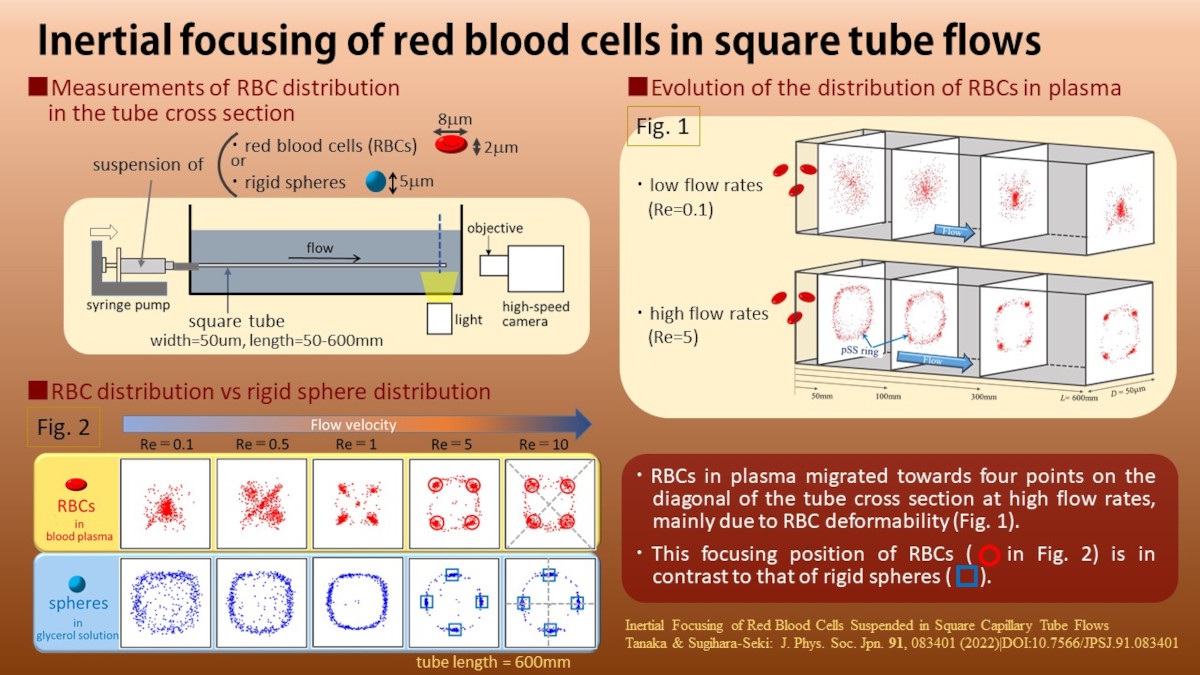Inertial Focusing of Red Blood Cells in Square Tube Flows
© The Physical Society of Japan
This article is on
Inertial Focusing of Red Blood Cells Suspended in Square Capillary Tube Flows
(JPSJ Editors' Choice)
J. Phys. Soc. Jpn. 91, 083401 (2022).
Red blood cells flowing through square capillary tubes were observed to migrate towards four points located on the diagonal in the tube cross-section, owing to their deformability and inertia.

Particles suspended in laminar flows through uniform, straight tubes are expected to move parallel to the tube axis. However, in experiments, particles migrate across streamlines due to the lifts induced by inertia, particle deformability, medium elasticity and so on. As a result, they pass through specific locations in the downstream cross-section. The presence of inertial lift was first reported concerning circular tube flows, where spherical particles suspended in a Newtonian fluid migrated towards an annulus located at approximately 0.6 times the tube radius from the tube centerline, named “inertial focusing”. In rectangular tube flows typically adopted in microfluidics, particles migrate towards several discrete points in the downstream cross-section. Particularly concerning square tube flows, spherical particles suspended in Newtonian fluids become concentrated at four points near the center of the side walls.
Recently, inertial focusing phenomena have gained considerable attention in the field of microfluidics owing to their promising application in separating and filtering biological cells. This flow-based separating technique using microfluidic devices is based on differences in the inertial focusing behavior of cells, depending on their size and deformability. Although biological cells are somewhat deformable, and suspending media usually contain various polymers, it is unclear how cell deformability and medium elasticity affect inertial focusing.
This study experimentally investigated the inertial focusing of red blood cells (RBCs) when suspended in blood plasma flowing through square cross-section capillary tubes. RBCs are known to be highly deformable, and the plasma contains various polymers (approximately 8% by volume). The face-on image of the tube cross-section near the outlet was taken from the downstream side using a high-speed camera, enabling accurate positions of RBC centroids in the cross-section to be obtained. At low flow rates, RBCs were observed to accumulate near the tube centerline, whereas increasing the flow rates caused RBCs to focus near four points located on the diagonal of the downstream cross-section. This focusing behavior significantly contrasts with that of the comparably sized rigid particles. Additional experiments using glutaraldehyde-hardened RBCs confirmed that the RBC focusing on the diagonal is primarily attributed to RBC deformability. A slight contribution of plasma elasticity was also suggested by the difference between the distributions of spherical particles suspended in plasma and those in Newtonian fluids. Based on the experimental results, the properties of deformability- and elasticity-induced lifts were discussed.
(written by M. Sugihara-Seki on behalf of all authors.)
Inertial Focusing of Red Blood Cells Suspended in Square Capillary Tube Flows
(JPSJ Editors' Choice)
J. Phys. Soc. Jpn. 91, 083401 (2022).
Share this topic
Fields
Related Articles
-
One-Way Optical Waveguide Realized by Edge Modes of Topological Photonic Crystals
Electromagnetism, optics, acoustics, heat transfer, and classical and fluid mechanics
Dielectric, optical, and other properties in condensed matter
2023-12-12
A one-way optical waveguide was realized on the boundary between two types of photonic crystals with different topological properties, which were demonstrated by high-resolution infrared reflection measurements.
-
Exploring Recent Advances in the Physics of Biofluid Locomotion
Measurement, instrumentation, and techniques
Cross-disciplinary physics and related areas of science and technology
Electromagnetism, optics, acoustics, heat transfer, and classical and fluid mechanics
Statistical physics and thermodynamics
Mathematical methods, classical and quantum physics, relativity, gravitation, numerical simulation, computational modeling
Structure and mechanical and thermal properties in condensed matter
2023-12-8
This Special Topics Edition of the JPSJ describes the latest advances in the field of biofluid locomotion, shedding light on the underlying physics behind the movement of organisms that swim and fly.
-
Microswimmer Hydrodynamics Through the Lens of Jeffery’s Orbits
Electromagnetism, optics, acoustics, heat transfer, and classical and fluid mechanics
Cross-disciplinary physics and related areas of science and technology
2023-5-18
This review article summarizes the latest progress on Jeffery’s orbits and how they relate to the motion of microswimmers of various shapes, including sperms, bacteria, and even microrobots.
-
A Two-step Creation of Phonon Entanglement with Quantized Light
Dielectric, optical, and other properties in condensed matter
Electromagnetism, optics, acoustics, heat transfer, and classical and fluid mechanics
Mathematical methods, classical and quantum physics, relativity, gravitation, numerical simulation, computational modeling
2021-12-28
Dynamics of photoinduced quantum entanglement generation between phonons is theoretically revealed. The results contribute to the study of fundamental theoretical problems within quantum dynamics of photoinduced phase transitions and quantum information science.
-
Of Spins and Atoms: Combining Rotations to Obtain Directed Motion
Magnetic properties in condensed matter
Electromagnetism, optics, acoustics, heat transfer, and classical and fluid mechanics
2021-3-22
The coupling between surface acoustic waves and spin waves is shown to depend strongly on the angle between the acoustic wavevector and magnetization. For a particular angle, it completely vanishes in one direction, which enables a unidirectional generation of surface acoustic waves by a ferromagnetic resonance.
